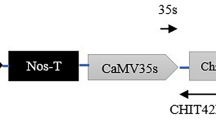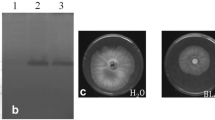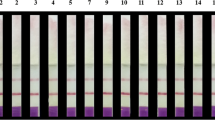Abstract
Сhitinases expressed by some beneficial fungi are crucial for the biocontrol of phytopathogens. The activity of chitinolytic strains of Trichoderma sp. may be enhanced by increasing the expression of chitinases. We describe the Trichoderma strain Mchit42 which expresses a transgenic chitinase chit42 from Metarhizium anisopliae. Inhibitory effects against plant pathogens were tested. Comparison of WT (T30) and OE (Mchit42) indicated that overexpression of M. anisopliaechit42 did not alter Trichoderma growth, while enhancing the expression of endogenous chitinase, β-1,3-glucanases, and polygalacturonase and increasing the antagonistic activity of Trichoderma against Botrytis cinerea. This work confirmed that the expression of the entomopathogenic fungi-sourced chit42 genes in Trichodermaharzianum enhances the efficiency of Trichoderma biocontrol against targeted pathogens.





Similar content being viewed by others
REFERENCES
Steyaert J.M., Stewart A., Jaspers M., Carpenter M., Ridgway H.J. 2004. Co-expression of two genes, a chitinase (chit42) and proteinase (prb1), implicated in mycoparasitism by Trichoderma hamatum. Mycologia. 96, 1245–1252.
Carrera E., Ruiz-Rivero O., Peres L.E., Atares A., Garcia-Martinez J.L. 2012. Characterization of the procera tomato mutant shows novel functions of the SlDELLA protein in the control of flower morphology, cell division and expansion, and the auxin-signaling pathway during fruit-set and development. Plant Physiol. 160, 1581–1596.
Chet I., Inbar J., Hadar I. 1997. Fungal antagonists and mycoparasites. In: The Mycota IV: Environmental and Microbial Relationships. Berlin: Springer-Verlag, 165–184.
Kowsari M., Motallebi M., Zamani R.M. 2014. Construction of new GFP-tagged fusants for Trichoderma harzianum with enhanced biocontrol activity. Plant Prot. Res. 54, 122−131.
Saksirirat W., Chareerak P., Bunyatrachata W. 2009. Induced systemic resistance of biocontrol fungus, Trichoderma spp. against bacterial and gray leaf spot in tomatoes. As. J. Food Ag-Ind. 2, 99–104.
Bolar J.P., Norelli J.L., Harman G.E., Brown S.K., Aldwinckle H.S. 2001. Synergistic activity of endochitinase and exochitinase from Trichoderma atroviride (T. harzianum) against the pathogenic fungus (Venturia inaequalis) in transgenic apple plants. Transgenic Res. 10, 533–543.
Grayston S.J. 1996. Rhizosphere carbon flow in trees, in comparison to annual plants: The importance of root exudation and its impact on microbial activity and nutrient cycling. Appl. Soil Ecol. 5, 29–56.
Cumagun C.J.R. 2012. Managing plant diseases and promoting sustainability and productivity with Trichoderma. J. Agric Sci. Technol. 14, 699–714.
Vinale F., Sivasithamparam K., Ghisalberti E.L, Marra R., Woo S.L, Lorito M. 2008. Trichoderma–plant–pathogen interactions. Soil Biol. Biochem. 40, 1−10.
Harman G.E, Howell C.R, Viterbo A., Chet I., Lorito M. 2004. Trichoderma species: Opportunistic, avirulent plant symbionts. Nat. Rev. 2, 43–56.
Lopez R.C, Gomez-Gomez L. 2009. Isolation of a new fungi and wound-induced chitinase class in corms of Crocus sativus plant. Physiol. Biochem. 47, 426–434.
Collinge D.B., Kragh K.M., Mikkelson J.D., Nielson K.K., Rasmussen U., Vad K. 1993. Plant chitinases. Plant J. 3, 31–40.
Gokul B., Lee J.H., Song K.B., Rhee S.K., Kim C.H., Panda T. 2000. Characterization and applications of chitinases from Trichoderma harzianum. Bioprocess Eng. 23, 691–694.
Harighi M.J., Zamani M.R., Motallebi M. 2007. Evaluation of antifungal activity of purified chitinase 42 from Trichoderma atroviride PTCC5220. Biotechnology. 6, 28–33.
Lee S.Y., Tindwa H., Lee Y.S., Naing K.W., Hong S.H., Nam Y., Kim K.Y. 2012. Biocontrol of anthracnose in pepper using chitinase, beta-1,3-glucanase, and 2-furancarboxaldehyde produced by Streptomyces cavourensis SY224. J. Microbiol. Biotechnol. 22, 1359–1366.
Haggag W.M., Abdallh E.G. 2012. Purification and characterization of chitinase produced by endophytic Streptomyces hygroscopicus against some phytopathogens. J. Microbiol. Res. 2, 145–151.
Limón M.C., Chacón M.R., Mejías R., Delgado-Jarana J., Rincón A.M., Codón A.C., Benítez T. 2004. Increased antifungal and chitinase specific activities of Trichoderma harzianum CECT 2413 by addition of a cellulose binding domain. Appl. Microbiol. Biotechnol. 64, 675–685.
Amin F., Razdan V.K., Mohiddin F.A., Bhat K.A., Banday S. 2010. Potential of Trichoderma species as biocontrol agents of soil borne fungal propagules. J. Phytol. 2, 38–41.
Harighi M.J., Motallebi M., Zamani M.R. 2006. Antifungal activity of heterologous expressed chitinase 42 (Chit42) from Trichoderma atroviride PTCC5220. Iran J. Biotech. 4, 95–103.
Steyaert J.M., Ridgway H.J., Elad Y. 2003. Genetic basis of mycoparasitism: A mechanism of biological control by species of Trichoderma. New Zeal. J. Crop Hort. Sci. 31, 281–291.
da Silva M.V., Santi L., Staats C.C., da Costa A.M., Colodel E.M., Driemeier D., Vainstein M.H., Schrank A. 2005. Cuticle-induced endo/exoacting chitinase CHIT30 from Metarhizium anisopliae is encoded by an ortholog of the chi3 gene. Res. Microbiol. 156, 382–392.
Bergemann S.E., Miller S.L., Garbelotto M. 2005. Microsatellite loci from Russula brevipes, a common ectomycorrhizal associate of several tree species in North America. Mol. Ecol. Notes. 5, 472–474.
García I., Lora J.M., de la Cruz J., Benítez T., Llobell A., Pintor-Toro J.A. 1994. Cloning and characterization of a chitinase (CHIT42) cDNA from the mycoparasitic fungus Trichoderma harzianum. Curr. Genet. 27, 83–89.
Gu J., Ye C. 2011. pYEMF, a pUC18-derived XcmI T‑vector for efficient cloning of PCR products. Mol. Biotechnol. 47, 229–233.
Kirubakaran S.I., Sakthivel N. 2007. Cloning and overexpression of antifungal barley chitinase gene in Escherichia coli. Protein Expr. Purif. 52, 159–166.
Mullins E.D., Chen X., Romaine P., Raina R., Geiser D.M., Kang S. 2001. Agrobacterium-mediated transformation of Fusarium oxysporum: An efficient tool for insertional mutagenesis and gene transfer. Phytopathology. 91, 173–180.
Reissig J., Strominger J., Leloir L. 1955. A modified colorimetric method for the estimation of N-acetylamino sugars. J. Biol. Chem. 217, 959–966.
Bonev B., Hooper J., Parisot J. 2008. Principles of assessing bacterial susceptibility to antibiotics using the agar diffusion method. J. Antimicrob. Chemother. 61, 1295–1301.
Frazzon A.P.G., Vaz I.S., Masuda A., Schrank A., Vainstein M.H. 2000. In vitro assessment of Metarhiaium anisopliae to control the tick Boophilus microplus. Vet. Parasitol. 94, 117–125.
Keller N.P., Turner G., Bennett J.W. 2005. Fungal secondary metabolism—from biochemistry to genomics. Nat. Rev. Microbiol. 3, 937–947.
Yu J.H., Keller N. 2005. Regulation of secondary metabolism in filamentous fungi. Annu. Rev. Phytopathol. 43, 437–458.
ACKONWLEDGMENTS
This work was supported by National Key Research and Development Program of China (2017YFD0200901 and 2017YFD0200400), National Natural Science Foundation of China (31672072) and Agricultural Extension Project of Shanghai Municipal Agricultural Commission (2017) no. 1-6. We thank the laboratory of Plant Pathology of Shanghai Jiaotong University for providing us Metarhizium anisopliae CY1 and Trichoderma harzianum T30.
Author information
Authors and Affiliations
Corresponding author
Additional information
1The article is published in the original.
Rights and permissions
About this article
Cite this article
Xia, H., Li, Y.Y., Liu, Z.C. et al. Transgenic Expression of chit42 gene from Metarhiziumanisopliae in Trichoderma harzianum Enhances Antagonistic Activity against Botrytis cinerea. Mol Biol 52, 668–675 (2018). https://doi.org/10.1134/S002689331805014X
Received:
Accepted:
Published:
Issue Date:
DOI: https://doi.org/10.1134/S002689331805014X




